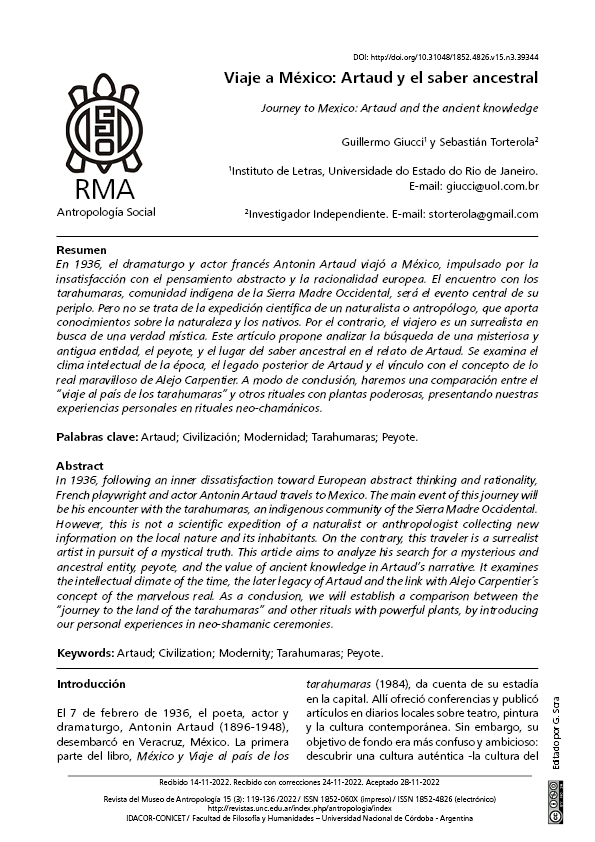Journey to Mexico
Artaud and the ancient knowledge
DOI:
https://doi.org/10.31048/1852.4826.v15.n3.39344Keywords:
Artaud, Civilization, Modernity, Tarahumaras, PeyoteAbstract
In 1936, following an inner dissatisfaction toward European abstract thinking and rationality, French playwright and actor Antonin Artaud travels to Mexico. The main event of this journey will be his encounter with the tarahumaras, an indigenous community of the Sierra Madre Occidental. However, this is not a scientific expedition of a naturalist or anthropologist collecting new information on the local nature and its inhabitants. On the contrary, this traveler is a surrealist artist in pursuit of a mystical truth. This article aims to analyze his search for a mysterious and ancestral entity, peyote, and the value of ancient knowledge in Artaud’s narrative. It examines the intellectual climate of the time, the later legacy of Artaud and the link with Alejo Carpentier´s concept of the marvelous real. As a conclusion, we will establish a comparison between the “journey to the land of the tarahumaras” and other rituals with powerful plants, by introducing our personal experiences in neo-shamanic ceremonies.
Downloads
References
Apud, I.; Carrera, I.; Scuro, J.; Montero, F. (2021). «¿Es posible desarrollar investigaciones clínicas utilizando sustancias psicodélicas en Uruguay?» Revista de Psiquiatría del Uruguay, vol 85, nº 1, 63-76. https://pesquisa.bvsalud.org/portal/resource/pt/biblio-1343170
Artaud, A. (1979). El teatro y su doble. Buenos Aires: Sudamericana.
Artaud, A. (1984). México y Viaje al país de los tarahumaras. México: Fondo de Cultura Económica.
Bonfiglioli, C. (2005). «Jíkuri sepawa’ame (la “raspa de peyote”): una danza de curación en la sierra Tarahumara». Revista del Instituto de Investigaciones Antropológicas. México: UNAM.
Bradu, F. (2008). Artaud, todavía. México: Fondo de Cultura Económica.
Carpentier, A. (1999). El reino de este mundo. Seix Barral: Barcelona.
Flores, E. (1999). «Artaud y el rito de los reyes de la Atlántida». Instituto de investigaciones filológicas, nº 1-2, México: UNAM, 187-224. https://doi.org/10.19130/iifl.litmex.10.1-2.1999.356
Glockner, J. (2016). La mirada interior. Plantas sagradas en el mundo amerindio. México: Debate.
Herf, J. (1986). Technology, culture, and politics in Weimar and the Third Reich. Cambridge: Cambridge University Press.
Huxley, A. (2014). The Doors of Perception. Canada: HarperCollins.
Krutak, L. (2014). (Sur)real or Unreal? Antonin Artaud in the Sierra Tarahumara of Mexico. Journal of Surrealism and the Americas. 8:1, 28-50. https://keep.lib.asu.edu/_flysystem/fedora/c159/8IssueKrutakPublished.pdf
Le Clézio, J. M. G. (2010). El sueño mexicano o el pensamiento interrumpido. México: Fondo de Cultura Económica.
Nieto Sánchez, V. (2018). «“Escrituras del ver”: viajes al país de los tarahumaras». Instituto de Literatura Comparada Margarida Losa. nº 38, 6, 295-318.
Paz, O. (1988). «María Izquierdo sitiada y situada». Vuelta, nº 144. México.
Reyes, A. (1992). Artaud. No se juega infamemente con los Dioses. Revista de la Universidad de México, junio, número 497, p. 6-7. https://www.revistadelauniversidad.mx/download/2925817d-ae00-4aa3-91a8-340784ce4391?filename=artaud-no-se-juega-infamemente-con-los-dioses
Schultes, R. E.; Hofmann, A. (2000). Plantas de los dioses. México: Fondo de Cultura Económica.
Scuro, J; Giucci, G; Torterola, S. (2018). «Camino Rojo from Mexico to Uruguay. Spiritual leaderships, trajectories and memory». International Journal of Latin American Religions, Springer, Switzerland. DOI: 10.1007/s41603-018-0055-4
Spengler, O. (1966). La decadencia de Occidente. 2 vols. Madrid: Espasa-Calpe.
Todorov, T. (2003). Nosotros y los otros. Reflexión sobre la diversidad humana. Buenos Aires: Siglo XXI.
Znamenski, A. (2007). The Beauty of the Primitive. Shamanism and the Western Imagination. Oxford: Oxford University Press.

Downloads
Published
Issue
Section
License
Copyright (c) 2022 Guillermo Giucci, Sebastián Torterola

This work is licensed under a Creative Commons Attribution-NonCommercial-ShareAlike 4.0 International License.
Those authors who have publications with this Journalaccept the following terms:
a. Authors will retain their copyrights and guarantee the journal the right of first publication of their work, which will be simultaneously subject to the Creative Commons Attribution License (Licencia de reconocimiento de Creative Commons) that allows third parties to share the work as long as its author and his first publication in this journal.
b. Authors may adopt other non-exclusive licensing agreements for the distribution of the version of the published work (eg, deposit it in an institutional electronic file or publish it in a monographic volume) provided that the initial publication in this journal is indicated.
c. Authors are allowed and recommended to disseminate their work on the Internet (eg in institutional telematic archives or on their website) before and during the submission process, which can lead to interesting exchanges and increase citations of the published work. (See The Effect of Open Access - El efecto del acceso abierto)











